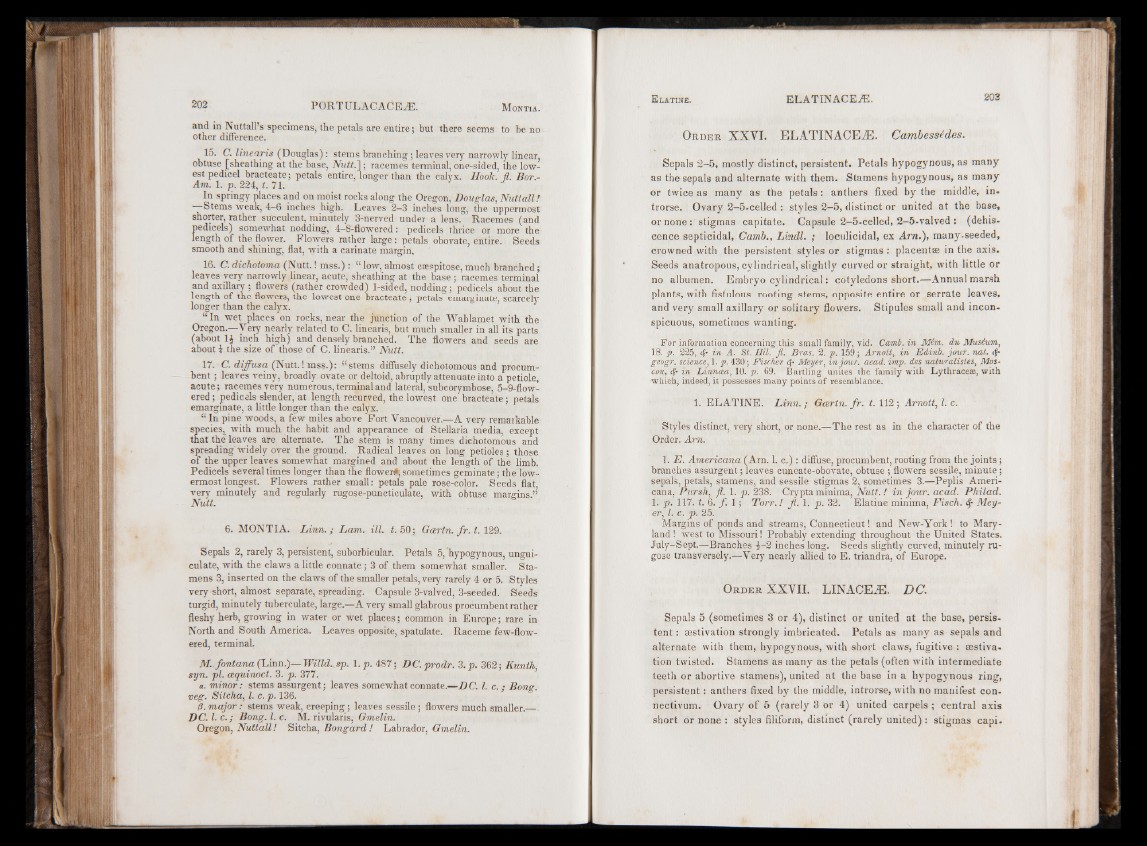
and in Nuttall1 s specimens, the petals are entire; but there seems to be no
other difference.
15. C. linearis (Douglas): stems branching; leaves very narrowly linear,
obtuse (sheathing at the base, Nutt.'] ; racemes terminal, one-sided, the lowest
pedicel bracteate; petals entire, longer than the calyx. Hook. fi. Bor.-
Am. 1. p, 224, t. 71. . J
In springy places and on moist rocks along the Oregon, Douglas, Nuttall!
Stems weak, 4-6 inches high. Leaves 2-3 inches long, the uppermost
shorter, rather succulent, minutely 3-nerved under a lens. Racemes (and
pedicels) somewhat nodding, 4-8-flowered: pedicels thrice or more the
length of the flower. Flowers rather large: petals obovate, entire. Seeds
smooth and shining, flat, with a carinate margin.
16. C. dichotoma (Nutt.! mss.) : “ low, almost crespitose, much branched;
leaves very narrowly linear, acute, sheathing at the base ; racemes terminal
and axillary; flowers (rather crowded) 1-sided, nodding; pedicels about the
length of the flowers, the lowest one bracteate ; petals emarginate, scarcely
longer than the calyx.
“ In wet places on rocks, near the junction of the Wahlamet with the
Oregon.—Very nearly related to C. linearis, but much smaller in all its parts
(about 1J inch high) and densely branched. The flowers and seeds are
about 4 the size of those of C. linearis.” Nutt.
17. C. diffusa (Nutt.! mss.): “ stems diffusely dichotomous and procumbent
; leaves veiny, broadly ovate or deltoid, abruptly attenuate into a petiole,
acute; racemes very numerous, terminal and lateral, subcorymbose, 5- 9-flow-
ered; pedicels slender, at length recurved, the lowest one bracteate; petals
emarginate, a little longer than the calyx.
“ In pine woods, a few miles above Fort Vancouver.—A very remarkable
species^ with much the habit and appearance of Stellaria media, except
that the leaves are alternate. The stem is many times dichotomous and
spreading widely over the ground. Radical leaves on long petioles; those
of the upper leaves somewhat margined and about the length of the limb.
Pedicels several times longer than the flower#; sometimes geminate; the lowermost
longest. Flowers rather small: petals pale rose-color. Seeds flat,
very minutely and regularly rugose-puncticulate, with obtuse margins.”
Nutt.
6. MONTIA. L in n .; Lam. ill. t. 50; Gcertn. f r . t . 129.
Sepals 2, rarely 3, persistent, suborbicular. Petals 5,'hypogynous, ungui-
culate, with the claws a little connate; 3 of them somewhat smaller. Stamens
3, inserted on the claws of the smaller petals, very rarely 4 or 5. Styles
very short, almost separate, spreading. Capsule 3-valved, 3-seeded. Seeds
turgid, minutely tuberculate, large.—A very small glabrous procumbent rather
fleshy herb, growing in water or wet places; common in Europe; rare in
North and South America. Leaves opposite, spatulate. Raceme few-flowered,
terminal.
M..fontana (Linn.)— Willd..sp. 1. p. 487; DC.prodr. 3,p . 362; Kunth,
syn. pi. cequinoct. 3. p. 377.
a . minor: stems assurgent; leaves somewhat connate.—DC. 1 . c .; Bong,
veg. Sitcha, l. c. p. 136.
0. m ajor: stems weak, creeping; leaves sessile; flowers much smaller.__
DC. 1. c.; Bong. 1. c. M. rivularis, Gmelin.
Oregon, Nuttall! Sitcha, Bongard! Labrador, Gmelin.
Or d er XXVI. E LA T IN AC EÆ . Cambessédes.
Sepals 2 -5 , mostly distinct, persistent. Petals hypogynous, as many
as the sepals and alternate with them. Stamens hypogynous, as many
or twice as many as the petals : anthers fixed by the middle, in-
trorse. Ovary 2-5-celled : styles 2 -5 , distinct or united at the base,
or none : ' stigmas capitate. Capsule 2-5-celled, 2 -5 -valved : (dehiscence
septicidal, Camb., Lindl. ; loculicidal, ex Am .), many-seeded,
crowned with the persistent styles or stigmas : placentae in the axis.
Seeds anatropous, cylindrical, slightly curved or straight, with little or
no albumen. Embryo cylindrical : cotyledons short.—Annual marsh
plants, with fistulous rooting stems, opposite entire or serrate leaves,
and very small axillary or solitary flowers. Stipules small and inconspicuous,
sometimes wanting.
For information concerning this small family, vid. Camb. in Mém. du Muséum,
18. p. 225, cf- in A. St. HU. ji. Bras. 2. p. 159 ; Arnott, in Edvnb. jour. nat. <f
geogr. science, 1. p. 430; Fischer Meyer, in jour. acad. imp. des naturalistes, Moscou,
cp in Linnoea, 10. p. 69. Bartling unites the family with Lythraceæ, with
which, indeed, it possesses many points of resemblance.
1. ELATINE. Linn. ; Gcertn. fr . t. 112 ; Arnott, l. c.
Styles distinct, very short, or none.—The rest as in the character of the
Order. Am.
1. E. Americana (Arn. 1. c.) : diffuse, procumbent, rooting from the joints ;
branches assurgent ; leaves cuneate-obovate, obtuse ; flowers sessile, minute ;
sepals, petals, stamens, and sessile stigmas 2, sometimes 3.—Peplis Americana,
Pursh, fl. 1. p. 238. Crypta minima, Nutt. ! in jour. acad. Philad.
1. p. 117. t. 6. f . 1 ; Torr. ! ji. 1. p. 32. Elatine minima, Fisch. <$■ Meyer,
l. c. p. 25.
Margins of ponds and streams, Connecticut ! and New-York! to Maryland!
west to Missouri ! Probably extending throughout the United States.
July-Sept.—Branches 4-2 inches long. Seeds slightly curved, minutely rugose
transversely .--Very nearly allied to E. triandra, of Europe.
Or d e r XXVII. LINACEÆ. DC.
Sepals 5 (sometimes 3 or 4), distinct or united at the base, persis-
tent : æstivation strongly imbricated. Petals as many as sepals and
alternate with them, hypogynous, with short claws, fugitive : æstivation
twisted. Stamens as many as the petals (often with intermediate
teeth or abortive stamens), united at the base in a hypogynous ring,
persistent : anthers fixed by the middle, introrse, with no manifest con-
nectivum. Ovary o f 5 (rarely 3 or 4) united carpels ; central axis
short or none : styles filiform, distinct (rarely united) : stigmas capi